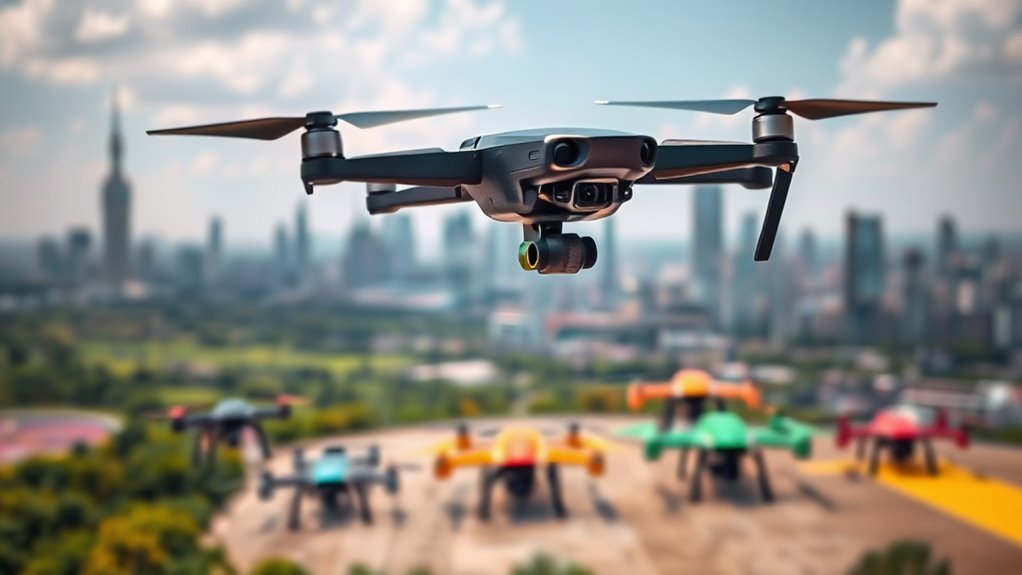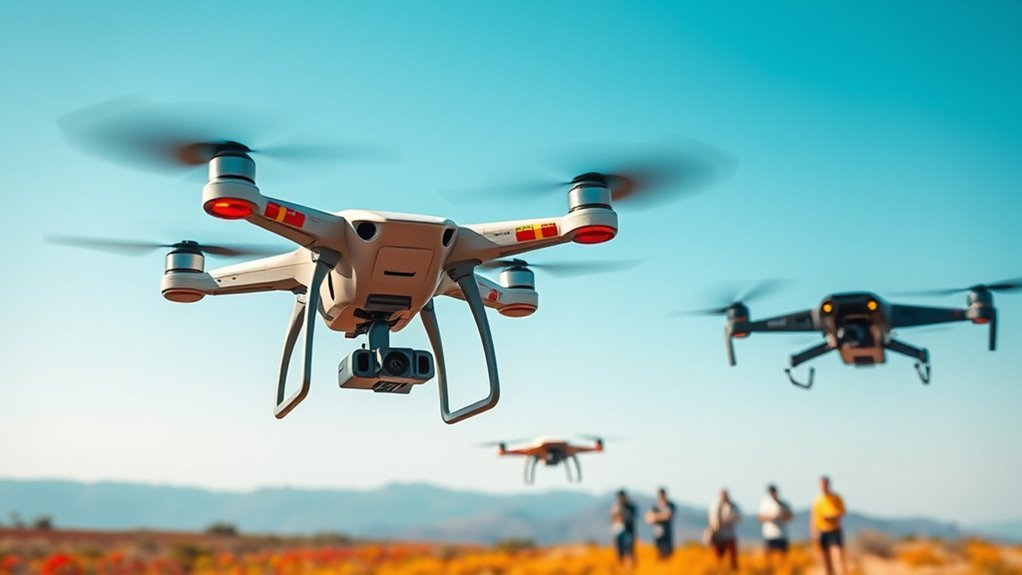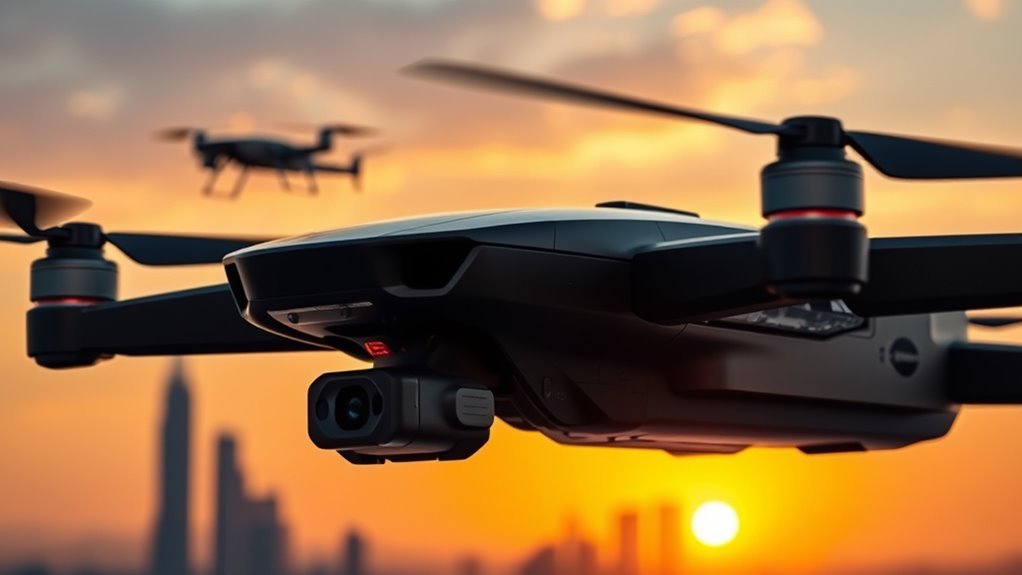Chinese drones have transformed aerial technology with advanced features, competitive pricing, and a variety of applications across industries like agriculture and logistics. Key players like DJI and Autel Robotics lead the market, offering popular models such as the Mavic Air 2 and EVO Lite. These drones boast impressive specs, including autonomous navigation and high-resolution photography. By understanding their innovations and market dynamics, you can navigate your options better. There’s more to explore about their future trends and regulatory considerations.
Overview of Chinese Drone Industry

As the demand for aerial technology grows, China’s drone industry has emerged as a global powerhouse, driving innovation and shaping market dynamics. You’ll find that this sector is heavily influenced by emerging technologies, ranging from advanced navigation systems to AI-driven analytics. However, despite its rapid growth, the industry faces numerous market challenges. Regulatory hurdles, international trade tensions, and competition from other countries can hinder progress. Additionally, maintaining quality while scaling production is a constant balancing act. As a consumer, you should keep an eye on how these factors will impact the availability and affordability of Chinese drones. Understanding these dynamics can empower you to make informed decisions about the technology that shapes your life and enhances your freedom.
Key Players in the Market

When you examine the Chinese drone market, several major manufacturers stand out, each carving out significant market share. Understanding these key players provides insight into industry dynamics and competition. You’ll see how their innovations and strategies shape the future of drone technology. Additionally, the rise of leading Chinese drone companies showcases their impact on global markets and competitive landscapes. The competitive landscape is further influenced by market dynamics that shape pricing and consumer preferences.
Major Manufacturers Overview
In today’s competitive landscape, major manufacturers of drones from China consistently dominate the global market. Companies like DJI, Yuneec, and Autel Robotics lead the charge, leveraging advanced drone technology and streamlined manufacturing processes to deliver high-quality products. By focusing on innovation, these manufacturers create drones that not only meet diverse consumer needs but also push the boundaries of what’s possible in aerial imaging, agriculture, and surveillance. Their ability to rapidly adapt to market trends and customer demands allows them to maintain a significant edge. Additionally, their strategic partnerships and investments in research and development guarantee that they stay at the forefront of the industry, making it essential for you to understand their impact on the ever-evolving drone landscape.
Market Share Analysis
The global drone market is heavily influenced by a few key players, with DJI consistently capturing the largest share, often exceeding 70%. This dominance shapes the market dynamics, creating a competitive landscape that other manufacturers must navigate. Understanding these key players can help you grasp the market’s direction.
- DJI: The undisputed leader, setting benchmarks in technology and innovation.
- Parrot: Focusing on commercial applications, aiming to carve out a niche market.
- Yuneec: Competing with a diverse range of consumer and commercial drones, emphasizing quality.
As these players vie for market share, their strategies and innovations will greatly impact the future of aerial technology, offering you a glimpse into a rapidly evolving landscape.
Popular Drone Models From China

Numerous popular drone models from China have captured the attention of both hobbyists and professionals alike. The rapid evolution of drone technology has led to an expansive market, where certain models stand out based on performance and features. Here’s a look at some models shaping current market trends:
| Drone Model | Key Features |
|---|---|
| DJI Mavic Air 2 | 4K camera, 34-min flight time |
| Autel Robotics EVO Lite | 6K video, obstacle avoidance |
| Hubsan Zino Pro | 4K camera, 23-min flight time |
These models not only highlight the innovation coming from China but also cater to various user needs, making them compelling choices in the ever-competitive drone landscape. Additionally, many of these drones, like the Potensic Atom SE, are designed to be lightweight and portable, making them ideal for spontaneous adventures. The Potensic Atom 2 exemplifies this with its lightweight, foldable design that enhances portability for on-the-go users.
Advanced Features of Chinese Drones
As drone technology continues to advance, you’ll find that Chinese manufacturers are at the forefront of incorporating cutting-edge features that enhance user experience and functionality. These advanced features not only improve performance but also redefine what’s possible in drone applications. Here are three standout attributes:
- Autonomous Navigation: Many Chinese drones come equipped with sophisticated algorithms that allow for seamless autonomous flight, enabling you to focus on capturing stunning visuals rather than piloting.
- High-Resolution Aerial Photography: With advanced camera systems, these drones offer exceptional image quality, perfect for both hobbyists and professionals seeking breathtaking aerial shots.
- Smart Obstacle Avoidance: Enhanced sensors allow drones to detect and navigate around obstacles, ensuring safer flights and reducing the risk of accidents.
Additionally, many of these drones are expected to feature AI-driven autonomous navigation by 2025, further enhancing flight safety and efficiency.
These features collectively elevate the capabilities of Chinese drones, making them a compelling choice for users.
Comparison of Pricing Strategies
While evaluating the landscape of drone pricing, it is essential to recognize that Chinese manufacturers employ diverse strategies tailored to various market segments. They often implement price differentiation strategies to cater to both budget-conscious consumers and high-end users. Some brands use market penetration tactics, offering lower initial prices to quickly capture market share. Additionally, affordable drone options offer a variety of features that appeal to a wide range of users.
| Strategy Type | Target Market | Example Brand |
|---|---|---|
| Price Differentiation | High-end users | DJI |
| Market Penetration | Budget-conscious buyers | Holy Stone |
| Competitive Pricing | Mid-range consumers | Potensic |
| Value-based Pricing | Professional users | Yuneec |
Additionally, budget-conscious consumers can find strong value in models like the Potensic Atom SE, which offers essential features at a competitive price point.
Performance and Flight Capabilities
When considering drones from China, you’ll want to focus on their flight time efficiency, range, and stability. These factors directly impact how effectively a drone can perform its intended tasks, whether for recreational use or commercial applications. Additionally, comparing payload capacities can reveal which models best suit your specific needs. Many models, like the DJI Mini 4K, offer advanced features that enhance performance and user experience. Drones like the DJI Air 3S provide longer flight endurance, allowing for extended exploration without interruptions.
Flight Time Efficiency
Flight time efficiency is a crucial aspect of drone performance, particularly for those manufactured in China, where technological advancements have propelled capabilities to new heights. When you evaluate flight time, consider these key factors:
- Battery Technology: Innovations in lithium-polymer and lithium-ion batteries are enhancing capacity and reducing weight, allowing for longer flights.
- Energy Efficiency: Aerodynamic designs and advanced propulsion systems minimize energy consumption, ensuring more time in the air.
- Payload Management: Efficient weight distribution and minimal additional load can dramatically impact overall flight duration.
Range and Stability
As you explore the performance and flight capabilities of Chinese drones, you’ll find that range and stability are pivotal factors that determine their effectiveness in various applications. Many models feature impressive range extension technologies, allowing you to cover vast distances without losing connectivity. This is particularly advantageous for surveillance, agriculture, or delivery services where long-range operation is essential.
In addition, advancements in stability enhancement create smoother flight experiences, even in challenging weather conditions. The incorporation of advanced sensors and stabilization algorithms guarantees that these drones maintain a steady trajectory, minimizing the risk of crashes or data loss. Ultimately, understanding these performance aspects can empower you to make informed decisions when selecting a drone suited to your specific needs.
Payload Capacity Comparison
While range and stability are essential for effective drone operation, payload capacity plays a significant role in determining how well a drone can perform specific tasks. Understanding the various payload types and their weight limits can enhance your decision-making process when choosing a drone for your needs. Here are three critical factors to contemplate:
- Weight Limits: Each drone has a maximum weight it can carry, affecting its flight time and stability.
- Payload Types: Different drones are designed to carry specific payloads, such as cameras, sensors, or delivery packages.
- Flight Capabilities: Higher payload capacities can impact maneuverability and battery life, so balance is key.
Applications in Various Industries
Drones from China are revolutionizing various industries, with numerous applications that enhance efficiency and productivity. In agriculture, they’re optimizing yields through precise monitoring and spraying. Drones also enable real-time monitoring of crop health, leading to quicker interventions and better resource management. Delivery services benefit from faster logistics, while aerial photography captures stunning visuals for media and real estate. Surveillance technology utilizes drones for enhanced security, making monitoring vast areas simpler. In construction, they’re crucial for real-time progress tracking and site safety assessments. Environmental monitoring helps track wildlife and pollution, and search and rescue missions are more effective with drone assistance. These tools also support recreational use, offering enthusiasts a unique aerial perspective. Finally, in disaster response, drones can quickly assess damage and deliver essential supplies, showcasing their versatility across sectors. Additionally, agriculture drones leverage precision planting techniques to ensure optimal seed placement and reduce waste, further enhancing productivity.
Regulatory Environment and Compliance
When considering drones from China, you’ve got to navigate a complex web of regulatory requirements. Understanding licensing and registration is essential, as well as ensuring compliance with local laws and export restrictions. This landscape not only affects how you operate but also influences your strategic decisions regarding drone deployment. Additionally, the necessity for NDAA compliance means that sourcing components from certain foreign entities, particularly those linked to China, can significantly impact your operational capabilities. Furthermore, drone safety regulations in regions like Dubai demonstrate the importance of adhering to strict guidelines to avoid legal repercussions.
Licensing and Registration Requirements
As you navigate the complex landscape of drone operations, understanding the licensing and registration requirements is essential for compliance and safety. Many drone enthusiasts face licensing challenges, often stemming from varying regulations across regions. Here are three key points to take into account:
- Registration Processes: Most countries require you to register your drone, which can involve submitting specific documentation and fees.
- Licensing Requirements: Depending on your drone’s weight and intended use, you may need to obtain a pilot’s license or a specific drone operator’s certificate.
- Continued Education: Staying informed about evolving regulations is vital, as compliance can change with new technology and safety standards.
Compliance With Local Laws
Steering through the regulatory environment surrounding drone operations requires a keen understanding of local laws, which can vary greatly from one jurisdiction to another. You’ll need to familiarize yourself with drone regulations specific to your area to guarantee local compliance. Ignoring these regulations can lead to hefty fines or even confiscation of your drone. Each region may have unique requirements regarding altitude limits, restricted airspace, and privacy concerns. Staying informed about changes in legislation is vital, as drone laws are constantly evolving. By proactively understanding and adhering to these regulations, you not only protect your freedom to fly but also contribute to a safer and more responsible drone community. So, take the time to research and stay compliant.
Export Restrictions and Policies
While traversing the complex landscape of drone exports, it’s vital to understand the various restrictions and policies that govern these transactions. These export controls can greatly impact your ability to engage with Chinese drone technology. Here are three key factors to take into account:
- Trade Policies: Different countries have unique trade agreements that can influence drone importation and exportation.
- Regulatory Compliance: Adhering to local and international regulations is critical to guarantee drones meet safety and operational standards.
- National Security Concerns: Many governments impose restrictions based on potential security risks associated with foreign drone technology.
Consumer and Professional User Perspectives
Understanding the perspectives of both consumer and professional drone users reveals a complex landscape shaped by diverse needs and expectations. Consumers often seek drones for recreational use, valuing user experiences that highlight ease of use, affordability, and versatility. They appreciate user feedback that emphasizes fun features like camera quality and flight stability. On the other hand, professional users demand high performance and reliability, focusing on technical specifications and advanced functionalities that support their work. They rely heavily on user feedback to guarantee that drones can endure rigorous conditions and meet specific industry standards. Balancing these differing priorities can be challenging, but it’s essential to understand what drives each group, ultimately shaping the future of drone technology and its applications. For instance, range and FPV capabilities are critical factors that influence both casual and professional drone selection. Additionally, many professionals look for drones with advanced imaging capabilities, as these features are crucial for achieving high-quality aerial photography and videography.
Future Trends and Innovations in Chinese Drones
As consumer and professional users continue to shape the drone market, the future of Chinese drones is poised for significant transformation. With advancements in autonomous technology, you’ll find exciting developments that enhance drone applications across various sectors. Here are three key trends to watch:
- Enhanced Autonomy: Drones will increasingly rely on AI for improved navigation and decision-making capabilities, making them more efficient. AI integration allows drones to focus on creative tasks while navigating complexities in their environment.
- Diverse Applications: Expect to see drones deployed in agriculture, logistics, and surveillance, broadening their utility and fostering innovation.
- Regulatory Adaptation: As regulations evolve, Chinese manufacturers will likely adapt their designs to guarantee compliance while maximizing performance.
These innovations not only promise to elevate convenience but also empower users, granting them greater freedom in how they harness drone technology.
Frequently Asked Questions
Are Chinese Drones Suitable for Beginners?
Chinese drones often come with beginner features and user-friendly options, making them suitable for newcomers. Their intuitive controls and accessible designs empower you to explore the skies with confidence, enhancing your flying experience right from the start.
How Do Chinese Drones Handle Adverse Weather Conditions?
Imagine a leaf dancing in the wind; similarly, Chinese drones often struggle in adverse weather. Their weather resistance varies, impacting flight stability. Some models handle conditions better, while others may falter, limiting your freedom to explore.
What Are the Warranty Options for Chinese Drones?
When considering warranty options for Chinese drones, you’ll find varying warranty coverage and duration. Typically, warranties last from six months to two years, reflecting the manufacturer’s commitment to quality and your investment protection.
Can Chinese Drones Be Repaired Easily?
Chinese drones can be repaired fairly easily, but it’s essential to know where to find repair parts. Following maintenance tips helps guarantee longevity, giving you more freedom to explore the skies without worry.
What Are Common Safety Concerns With Chinese Drones?
When considering safety concerns with drones, you should note regulatory compliance issues and potential privacy concerns. Understanding these factors helps guarantee you operate within legal boundaries while respecting the privacy of others during flights.

